Strategic Planning Analysis for The Hoxton in the Hospitality Sector
VerifiedAdded on 2023/01/05
|10
|3307
|59
Report
AI Summary
This report provides a strategic analysis of The Hoxton hotel within the hospitality industry. It begins with an introduction to strategic planning and its importance, followed by an examination of joint ventures as a potential strategy for The Hoxton's expansion. The report critically analyzes factors influencing the implementation of a joint venture, considering both merits and challenges such as new insights, flexibility, customer relationships, imbalance in involvement, cultural clashes, and the need for extensive planning. Furthermore, the report explores creative business strategies for The Hoxton to remain competitive, including cost leadership, differentiation, and focus strategies, ultimately recommending a focus strategy. The report also evaluates performance metrics like critical success factors (revenue, product performance, and profit margins), key performance indicators, and the balanced scorecard, providing a comprehensive overview of strategic planning within the context of the hospitality industry.
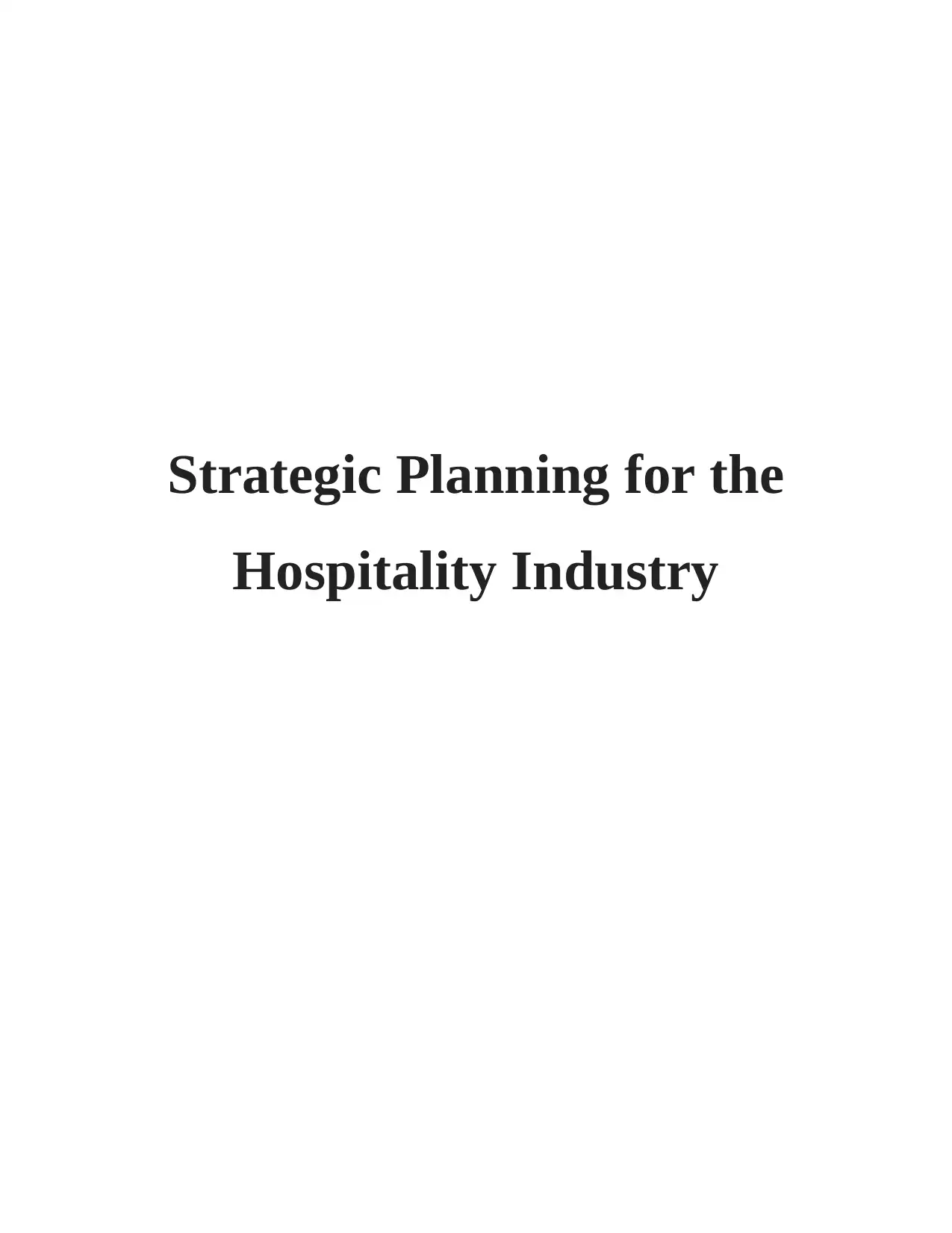
Strategic Planning for the
Hospitality Industry
Hospitality Industry
Paraphrase This Document
Need a fresh take? Get an instant paraphrase of this document with our AI Paraphraser
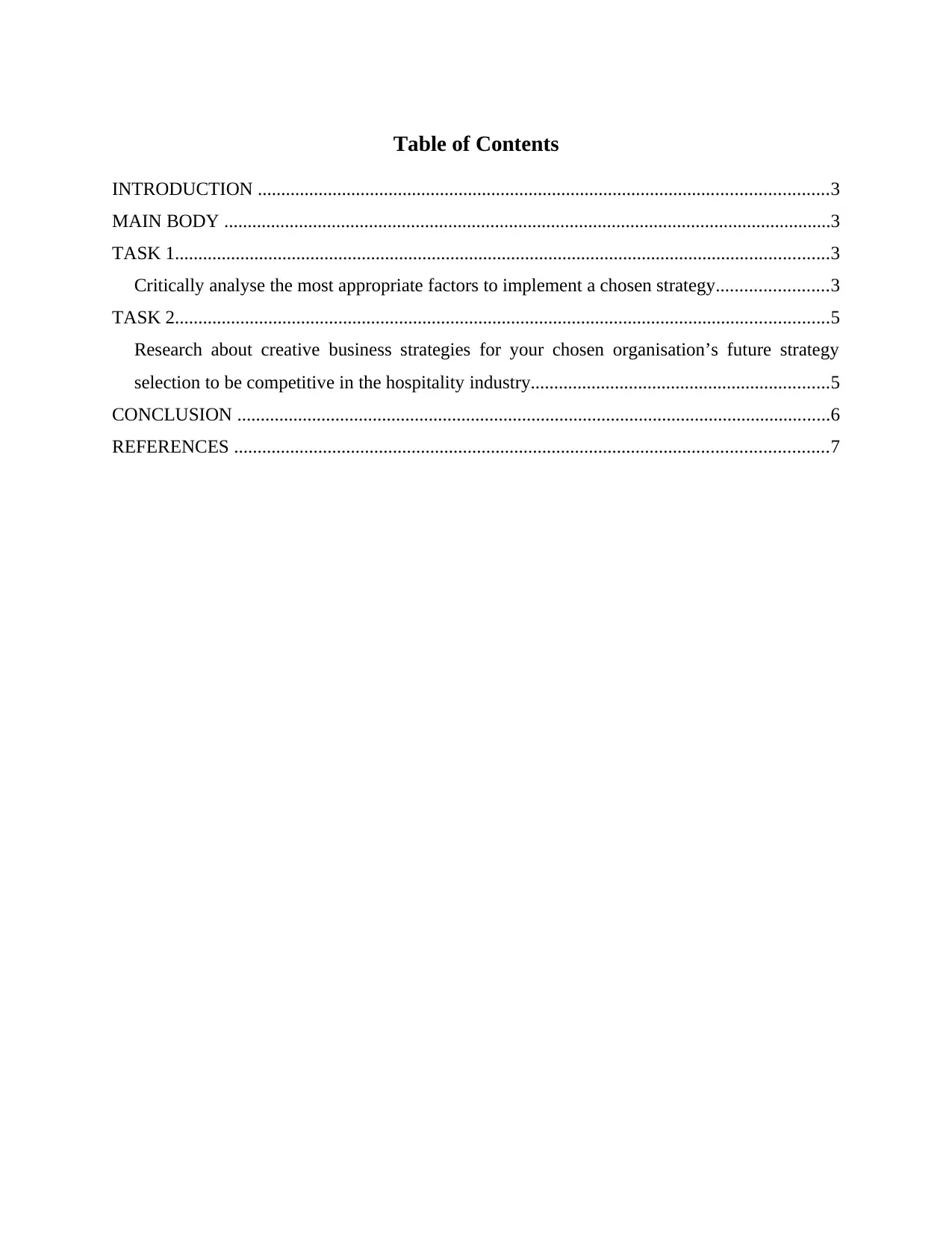
Table of Contents
INTRODUCTION ..........................................................................................................................3
MAIN BODY ..................................................................................................................................3
TASK 1............................................................................................................................................3
Critically analyse the most appropriate factors to implement a chosen strategy........................3
TASK 2............................................................................................................................................5
Research about creative business strategies for your chosen organisation’s future strategy
selection to be competitive in the hospitality industry................................................................5
CONCLUSION ...............................................................................................................................6
REFERENCES ...............................................................................................................................7
INTRODUCTION ..........................................................................................................................3
MAIN BODY ..................................................................................................................................3
TASK 1............................................................................................................................................3
Critically analyse the most appropriate factors to implement a chosen strategy........................3
TASK 2............................................................................................................................................5
Research about creative business strategies for your chosen organisation’s future strategy
selection to be competitive in the hospitality industry................................................................5
CONCLUSION ...............................................................................................................................6
REFERENCES ...............................................................................................................................7
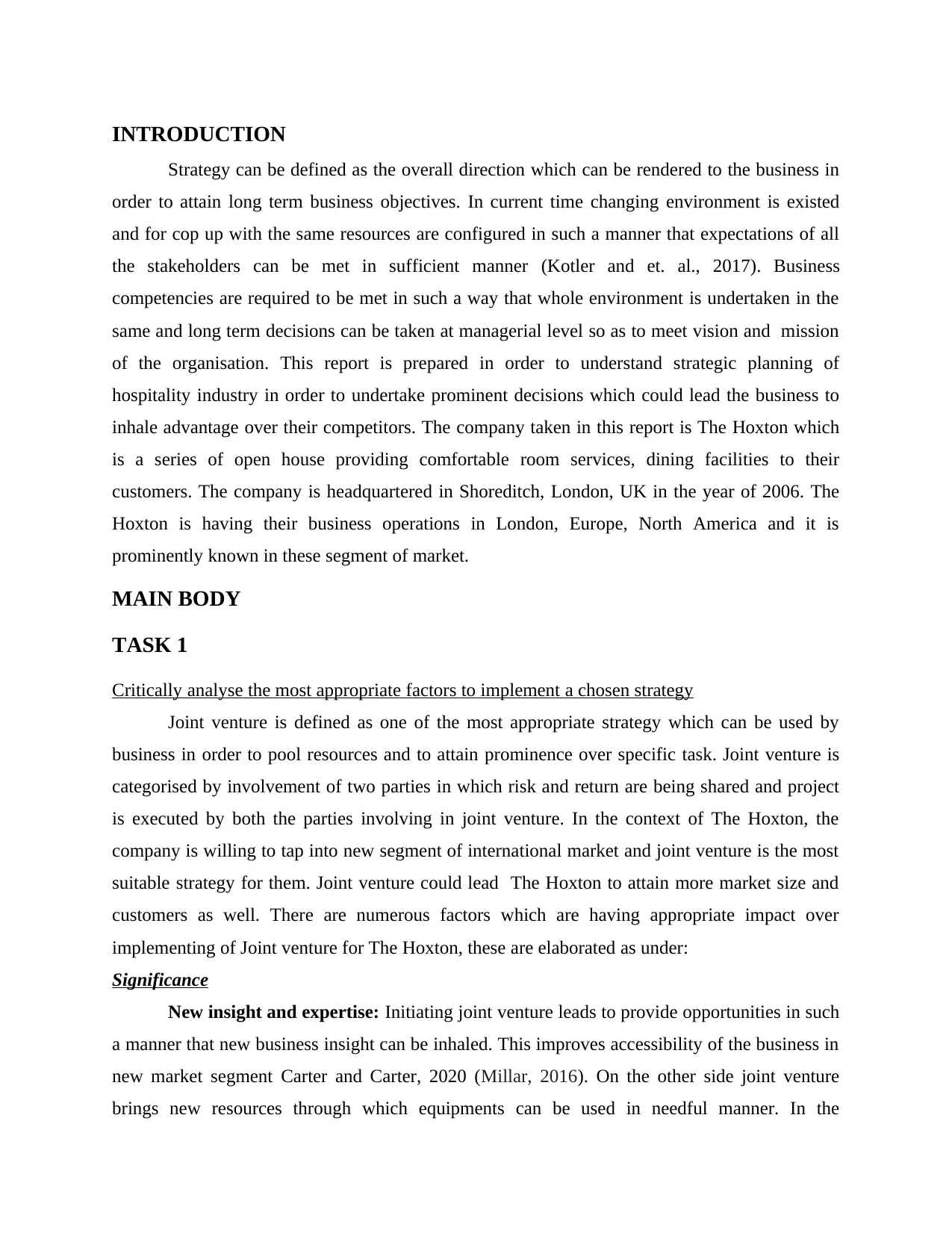
INTRODUCTION
Strategy can be defined as the overall direction which can be rendered to the business in
order to attain long term business objectives. In current time changing environment is existed
and for cop up with the same resources are configured in such a manner that expectations of all
the stakeholders can be met in sufficient manner (Kotler and et. al., 2017). Business
competencies are required to be met in such a way that whole environment is undertaken in the
same and long term decisions can be taken at managerial level so as to meet vision and mission
of the organisation. This report is prepared in order to understand strategic planning of
hospitality industry in order to undertake prominent decisions which could lead the business to
inhale advantage over their competitors. The company taken in this report is The Hoxton which
is a series of open house providing comfortable room services, dining facilities to their
customers. The company is headquartered in Shoreditch, London, UK in the year of 2006. The
Hoxton is having their business operations in London, Europe, North America and it is
prominently known in these segment of market.
MAIN BODY
TASK 1
Critically analyse the most appropriate factors to implement a chosen strategy
Joint venture is defined as one of the most appropriate strategy which can be used by
business in order to pool resources and to attain prominence over specific task. Joint venture is
categorised by involvement of two parties in which risk and return are being shared and project
is executed by both the parties involving in joint venture. In the context of The Hoxton, the
company is willing to tap into new segment of international market and joint venture is the most
suitable strategy for them. Joint venture could lead The Hoxton to attain more market size and
customers as well. There are numerous factors which are having appropriate impact over
implementing of Joint venture for The Hoxton, these are elaborated as under:
Significance
New insight and expertise: Initiating joint venture leads to provide opportunities in such
a manner that new business insight can be inhaled. This improves accessibility of the business in
new market segment Carter and Carter, 2020 (Millar, 2016). On the other side joint venture
brings new resources through which equipments can be used in needful manner. In the
Strategy can be defined as the overall direction which can be rendered to the business in
order to attain long term business objectives. In current time changing environment is existed
and for cop up with the same resources are configured in such a manner that expectations of all
the stakeholders can be met in sufficient manner (Kotler and et. al., 2017). Business
competencies are required to be met in such a way that whole environment is undertaken in the
same and long term decisions can be taken at managerial level so as to meet vision and mission
of the organisation. This report is prepared in order to understand strategic planning of
hospitality industry in order to undertake prominent decisions which could lead the business to
inhale advantage over their competitors. The company taken in this report is The Hoxton which
is a series of open house providing comfortable room services, dining facilities to their
customers. The company is headquartered in Shoreditch, London, UK in the year of 2006. The
Hoxton is having their business operations in London, Europe, North America and it is
prominently known in these segment of market.
MAIN BODY
TASK 1
Critically analyse the most appropriate factors to implement a chosen strategy
Joint venture is defined as one of the most appropriate strategy which can be used by
business in order to pool resources and to attain prominence over specific task. Joint venture is
categorised by involvement of two parties in which risk and return are being shared and project
is executed by both the parties involving in joint venture. In the context of The Hoxton, the
company is willing to tap into new segment of international market and joint venture is the most
suitable strategy for them. Joint venture could lead The Hoxton to attain more market size and
customers as well. There are numerous factors which are having appropriate impact over
implementing of Joint venture for The Hoxton, these are elaborated as under:
Significance
New insight and expertise: Initiating joint venture leads to provide opportunities in such
a manner that new business insight can be inhaled. This improves accessibility of the business in
new market segment Carter and Carter, 2020 (Millar, 2016). On the other side joint venture
brings new resources through which equipments can be used in needful manner. In the
⊘ This is a preview!⊘
Do you want full access?
Subscribe today to unlock all pages.

Trusted by 1+ million students worldwide
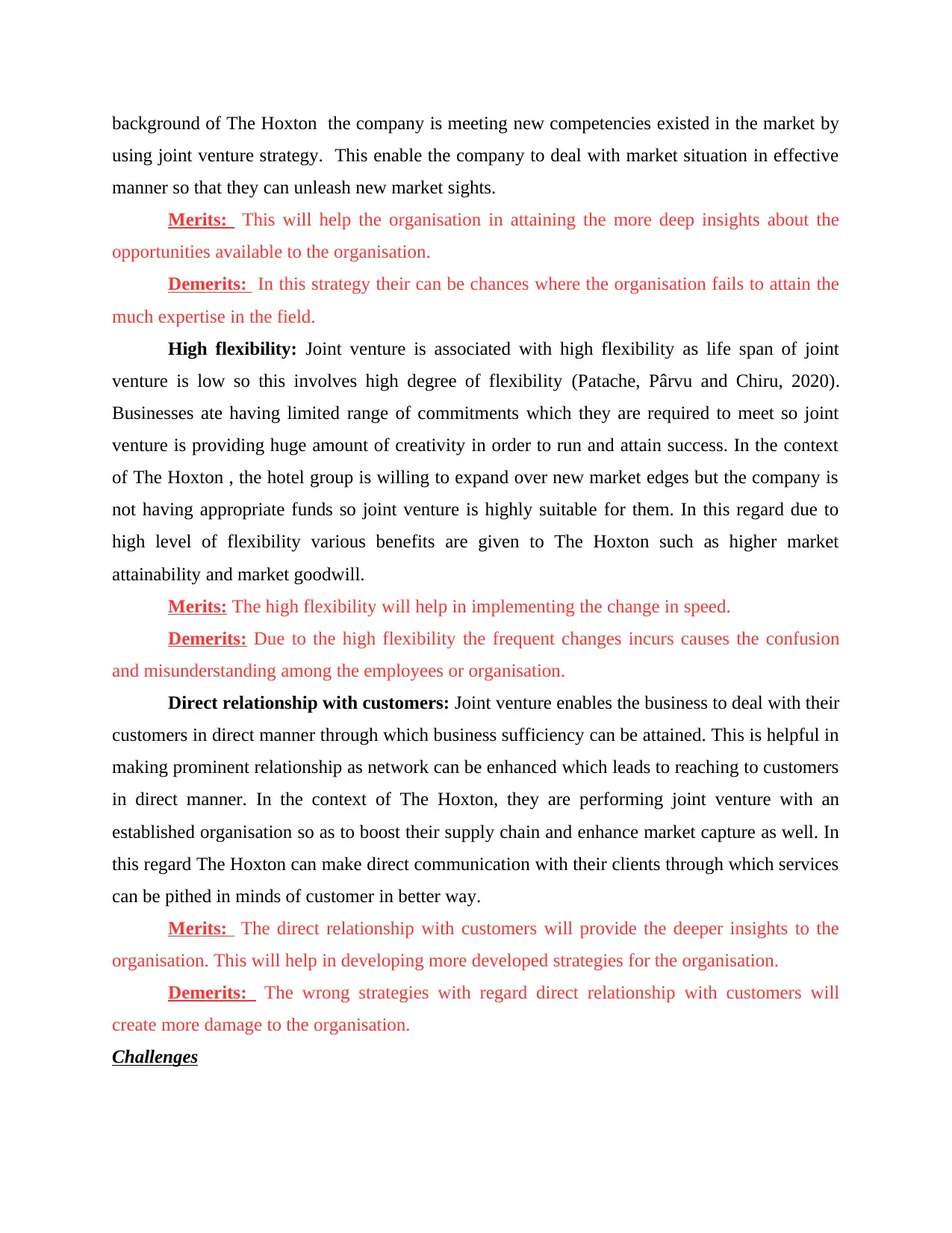
background of The Hoxton the company is meeting new competencies existed in the market by
using joint venture strategy. This enable the company to deal with market situation in effective
manner so that they can unleash new market sights.
Merits: This will help the organisation in attaining the more deep insights about the
opportunities available to the organisation.
Demerits: In this strategy their can be chances where the organisation fails to attain the
much expertise in the field.
High flexibility: Joint venture is associated with high flexibility as life span of joint
venture is low so this involves high degree of flexibility (Patache, Pârvu and Chiru, 2020).
Businesses ate having limited range of commitments which they are required to meet so joint
venture is providing huge amount of creativity in order to run and attain success. In the context
of The Hoxton , the hotel group is willing to expand over new market edges but the company is
not having appropriate funds so joint venture is highly suitable for them. In this regard due to
high level of flexibility various benefits are given to The Hoxton such as higher market
attainability and market goodwill.
Merits: The high flexibility will help in implementing the change in speed.
Demerits: Due to the high flexibility the frequent changes incurs causes the confusion
and misunderstanding among the employees or organisation.
Direct relationship with customers: Joint venture enables the business to deal with their
customers in direct manner through which business sufficiency can be attained. This is helpful in
making prominent relationship as network can be enhanced which leads to reaching to customers
in direct manner. In the context of The Hoxton, they are performing joint venture with an
established organisation so as to boost their supply chain and enhance market capture as well. In
this regard The Hoxton can make direct communication with their clients through which services
can be pithed in minds of customer in better way.
Merits: The direct relationship with customers will provide the deeper insights to the
organisation. This will help in developing more developed strategies for the organisation.
Demerits: The wrong strategies with regard direct relationship with customers will
create more damage to the organisation.
Challenges
using joint venture strategy. This enable the company to deal with market situation in effective
manner so that they can unleash new market sights.
Merits: This will help the organisation in attaining the more deep insights about the
opportunities available to the organisation.
Demerits: In this strategy their can be chances where the organisation fails to attain the
much expertise in the field.
High flexibility: Joint venture is associated with high flexibility as life span of joint
venture is low so this involves high degree of flexibility (Patache, Pârvu and Chiru, 2020).
Businesses ate having limited range of commitments which they are required to meet so joint
venture is providing huge amount of creativity in order to run and attain success. In the context
of The Hoxton , the hotel group is willing to expand over new market edges but the company is
not having appropriate funds so joint venture is highly suitable for them. In this regard due to
high level of flexibility various benefits are given to The Hoxton such as higher market
attainability and market goodwill.
Merits: The high flexibility will help in implementing the change in speed.
Demerits: Due to the high flexibility the frequent changes incurs causes the confusion
and misunderstanding among the employees or organisation.
Direct relationship with customers: Joint venture enables the business to deal with their
customers in direct manner through which business sufficiency can be attained. This is helpful in
making prominent relationship as network can be enhanced which leads to reaching to customers
in direct manner. In the context of The Hoxton, they are performing joint venture with an
established organisation so as to boost their supply chain and enhance market capture as well. In
this regard The Hoxton can make direct communication with their clients through which services
can be pithed in minds of customer in better way.
Merits: The direct relationship with customers will provide the deeper insights to the
organisation. This will help in developing more developed strategies for the organisation.
Demerits: The wrong strategies with regard direct relationship with customers will
create more damage to the organisation.
Challenges
Paraphrase This Document
Need a fresh take? Get an instant paraphrase of this document with our AI Paraphraser
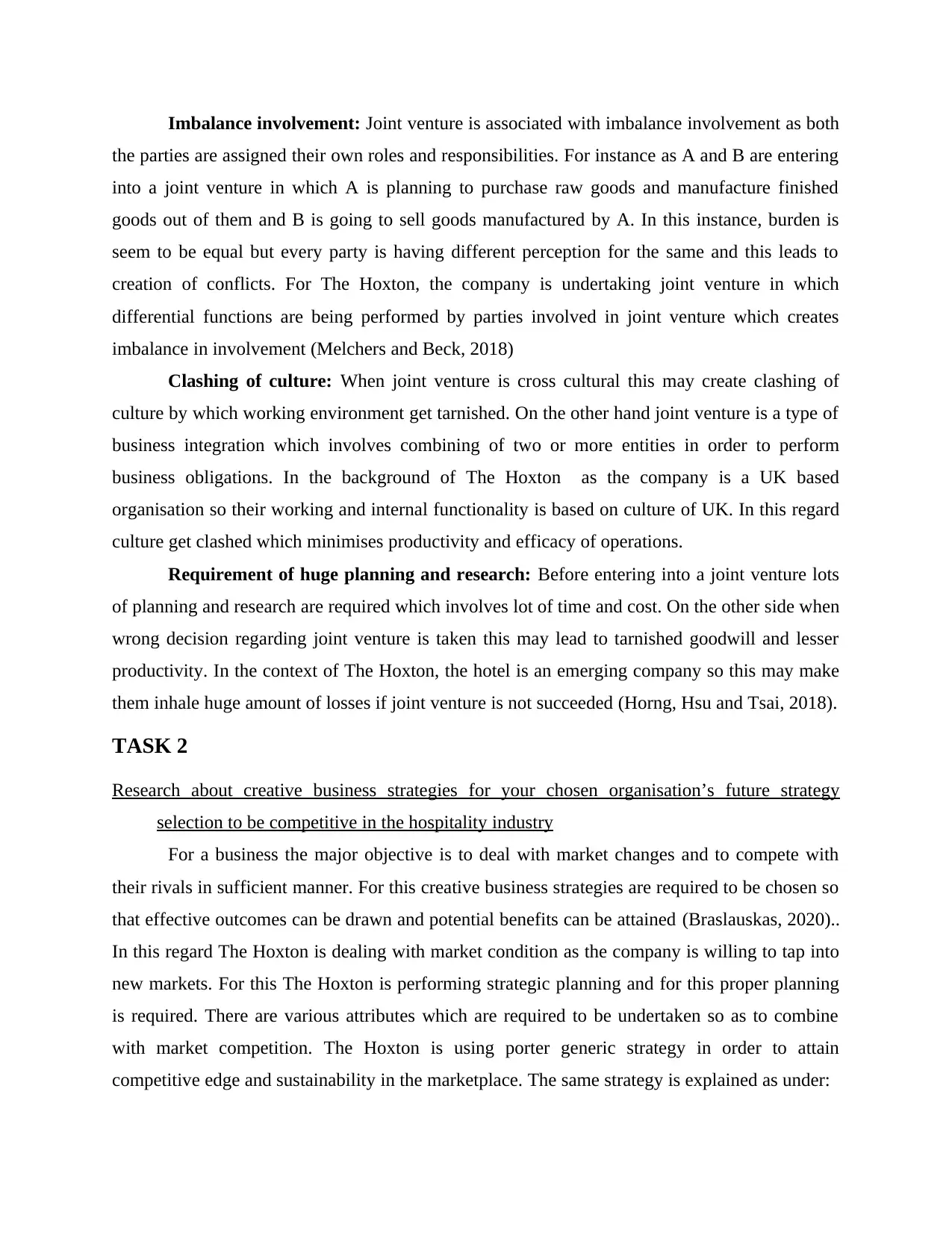
Imbalance involvement: Joint venture is associated with imbalance involvement as both
the parties are assigned their own roles and responsibilities. For instance as A and B are entering
into a joint venture in which A is planning to purchase raw goods and manufacture finished
goods out of them and B is going to sell goods manufactured by A. In this instance, burden is
seem to be equal but every party is having different perception for the same and this leads to
creation of conflicts. For The Hoxton, the company is undertaking joint venture in which
differential functions are being performed by parties involved in joint venture which creates
imbalance in involvement (Melchers and Beck, 2018)
Clashing of culture: When joint venture is cross cultural this may create clashing of
culture by which working environment get tarnished. On the other hand joint venture is a type of
business integration which involves combining of two or more entities in order to perform
business obligations. In the background of The Hoxton as the company is a UK based
organisation so their working and internal functionality is based on culture of UK. In this regard
culture get clashed which minimises productivity and efficacy of operations.
Requirement of huge planning and research: Before entering into a joint venture lots
of planning and research are required which involves lot of time and cost. On the other side when
wrong decision regarding joint venture is taken this may lead to tarnished goodwill and lesser
productivity. In the context of The Hoxton, the hotel is an emerging company so this may make
them inhale huge amount of losses if joint venture is not succeeded (Horng, Hsu and Tsai, 2018).
TASK 2
Research about creative business strategies for your chosen organisation’s future strategy
selection to be competitive in the hospitality industry
For a business the major objective is to deal with market changes and to compete with
their rivals in sufficient manner. For this creative business strategies are required to be chosen so
that effective outcomes can be drawn and potential benefits can be attained (Braslauskas, 2020)..
In this regard The Hoxton is dealing with market condition as the company is willing to tap into
new markets. For this The Hoxton is performing strategic planning and for this proper planning
is required. There are various attributes which are required to be undertaken so as to combine
with market competition. The Hoxton is using porter generic strategy in order to attain
competitive edge and sustainability in the marketplace. The same strategy is explained as under:
the parties are assigned their own roles and responsibilities. For instance as A and B are entering
into a joint venture in which A is planning to purchase raw goods and manufacture finished
goods out of them and B is going to sell goods manufactured by A. In this instance, burden is
seem to be equal but every party is having different perception for the same and this leads to
creation of conflicts. For The Hoxton, the company is undertaking joint venture in which
differential functions are being performed by parties involved in joint venture which creates
imbalance in involvement (Melchers and Beck, 2018)
Clashing of culture: When joint venture is cross cultural this may create clashing of
culture by which working environment get tarnished. On the other hand joint venture is a type of
business integration which involves combining of two or more entities in order to perform
business obligations. In the background of The Hoxton as the company is a UK based
organisation so their working and internal functionality is based on culture of UK. In this regard
culture get clashed which minimises productivity and efficacy of operations.
Requirement of huge planning and research: Before entering into a joint venture lots
of planning and research are required which involves lot of time and cost. On the other side when
wrong decision regarding joint venture is taken this may lead to tarnished goodwill and lesser
productivity. In the context of The Hoxton, the hotel is an emerging company so this may make
them inhale huge amount of losses if joint venture is not succeeded (Horng, Hsu and Tsai, 2018).
TASK 2
Research about creative business strategies for your chosen organisation’s future strategy
selection to be competitive in the hospitality industry
For a business the major objective is to deal with market changes and to compete with
their rivals in sufficient manner. For this creative business strategies are required to be chosen so
that effective outcomes can be drawn and potential benefits can be attained (Braslauskas, 2020)..
In this regard The Hoxton is dealing with market condition as the company is willing to tap into
new markets. For this The Hoxton is performing strategic planning and for this proper planning
is required. There are various attributes which are required to be undertaken so as to combine
with market competition. The Hoxton is using porter generic strategy in order to attain
competitive edge and sustainability in the marketplace. The same strategy is explained as under:
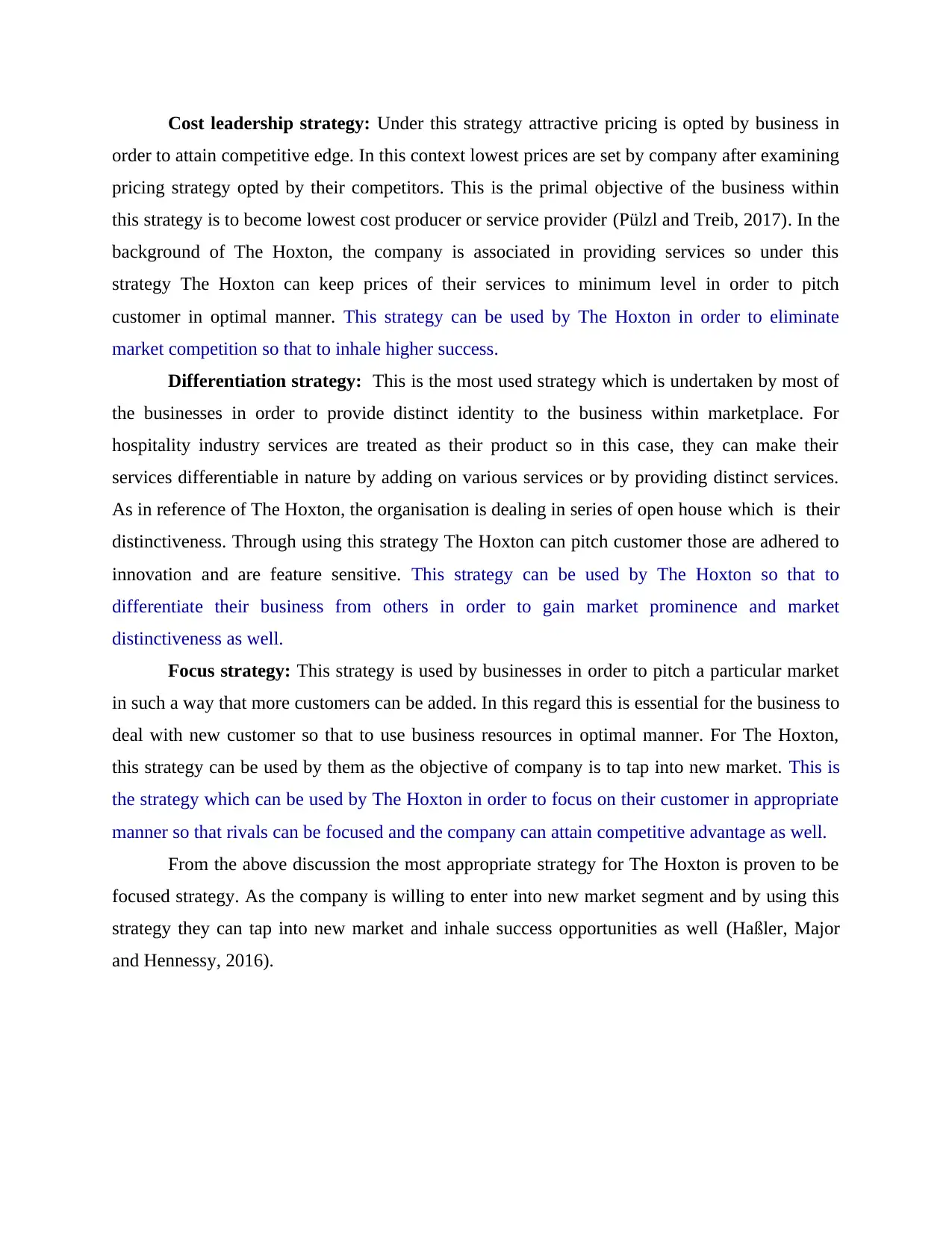
Cost leadership strategy: Under this strategy attractive pricing is opted by business in
order to attain competitive edge. In this context lowest prices are set by company after examining
pricing strategy opted by their competitors. This is the primal objective of the business within
this strategy is to become lowest cost producer or service provider (Pülzl and Treib, 2017). In the
background of The Hoxton, the company is associated in providing services so under this
strategy The Hoxton can keep prices of their services to minimum level in order to pitch
customer in optimal manner. This strategy can be used by The Hoxton in order to eliminate
market competition so that to inhale higher success.
Differentiation strategy: This is the most used strategy which is undertaken by most of
the businesses in order to provide distinct identity to the business within marketplace. For
hospitality industry services are treated as their product so in this case, they can make their
services differentiable in nature by adding on various services or by providing distinct services.
As in reference of The Hoxton, the organisation is dealing in series of open house which is their
distinctiveness. Through using this strategy The Hoxton can pitch customer those are adhered to
innovation and are feature sensitive. This strategy can be used by The Hoxton so that to
differentiate their business from others in order to gain market prominence and market
distinctiveness as well.
Focus strategy: This strategy is used by businesses in order to pitch a particular market
in such a way that more customers can be added. In this regard this is essential for the business to
deal with new customer so that to use business resources in optimal manner. For The Hoxton,
this strategy can be used by them as the objective of company is to tap into new market. This is
the strategy which can be used by The Hoxton in order to focus on their customer in appropriate
manner so that rivals can be focused and the company can attain competitive advantage as well.
From the above discussion the most appropriate strategy for The Hoxton is proven to be
focused strategy. As the company is willing to enter into new market segment and by using this
strategy they can tap into new market and inhale success opportunities as well (Haßler, Major
and Hennessy, 2016).
order to attain competitive edge. In this context lowest prices are set by company after examining
pricing strategy opted by their competitors. This is the primal objective of the business within
this strategy is to become lowest cost producer or service provider (Pülzl and Treib, 2017). In the
background of The Hoxton, the company is associated in providing services so under this
strategy The Hoxton can keep prices of their services to minimum level in order to pitch
customer in optimal manner. This strategy can be used by The Hoxton in order to eliminate
market competition so that to inhale higher success.
Differentiation strategy: This is the most used strategy which is undertaken by most of
the businesses in order to provide distinct identity to the business within marketplace. For
hospitality industry services are treated as their product so in this case, they can make their
services differentiable in nature by adding on various services or by providing distinct services.
As in reference of The Hoxton, the organisation is dealing in series of open house which is their
distinctiveness. Through using this strategy The Hoxton can pitch customer those are adhered to
innovation and are feature sensitive. This strategy can be used by The Hoxton so that to
differentiate their business from others in order to gain market prominence and market
distinctiveness as well.
Focus strategy: This strategy is used by businesses in order to pitch a particular market
in such a way that more customers can be added. In this regard this is essential for the business to
deal with new customer so that to use business resources in optimal manner. For The Hoxton,
this strategy can be used by them as the objective of company is to tap into new market. This is
the strategy which can be used by The Hoxton in order to focus on their customer in appropriate
manner so that rivals can be focused and the company can attain competitive advantage as well.
From the above discussion the most appropriate strategy for The Hoxton is proven to be
focused strategy. As the company is willing to enter into new market segment and by using this
strategy they can tap into new market and inhale success opportunities as well (Haßler, Major
and Hennessy, 2016).
⊘ This is a preview!⊘
Do you want full access?
Subscribe today to unlock all pages.

Trusted by 1+ million students worldwide
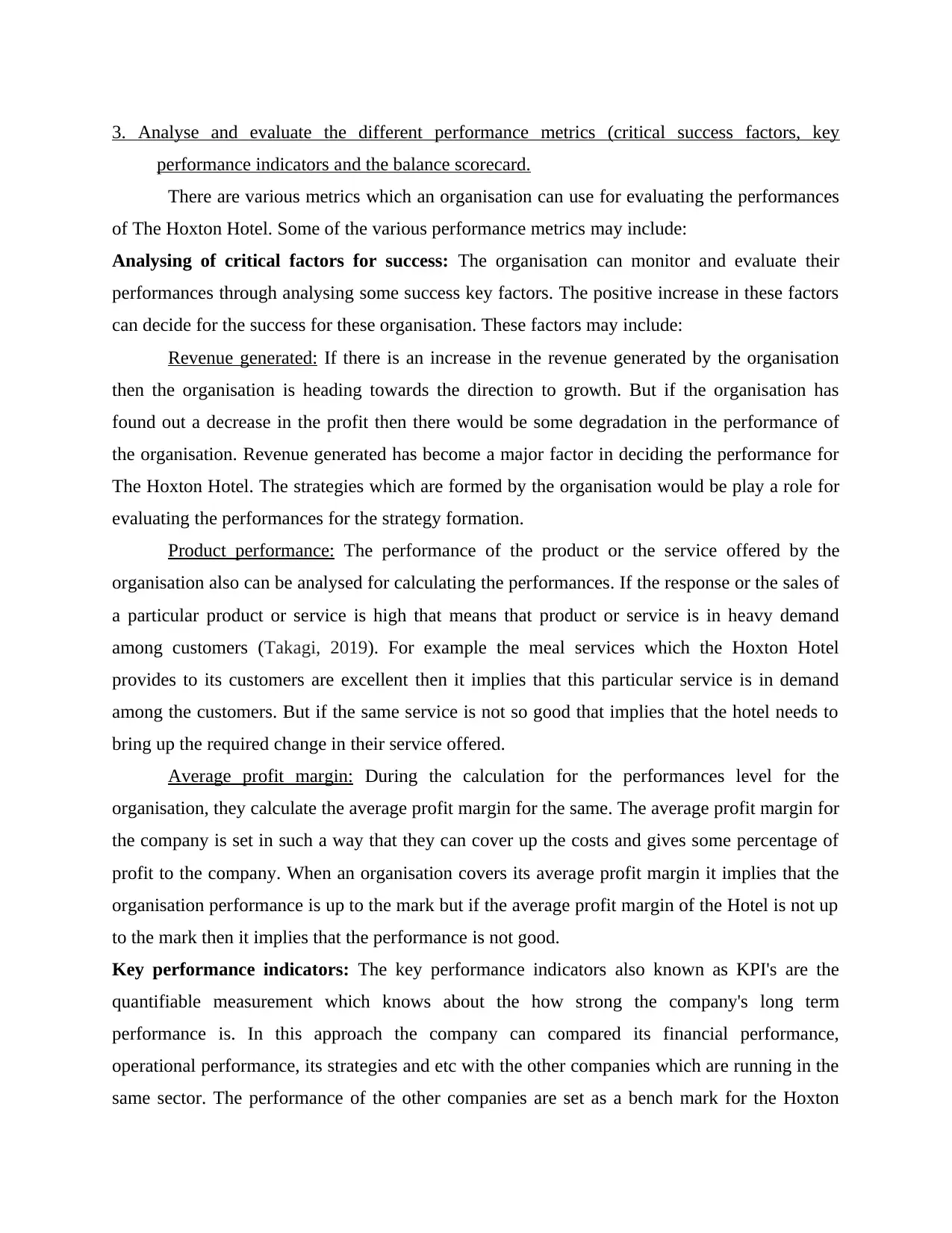
3. Analyse and evaluate the different performance metrics (critical success factors, key
performance indicators and the balance scorecard.
There are various metrics which an organisation can use for evaluating the performances
of The Hoxton Hotel. Some of the various performance metrics may include:
Analysing of critical factors for success: The organisation can monitor and evaluate their
performances through analysing some success key factors. The positive increase in these factors
can decide for the success for these organisation. These factors may include:
Revenue generated: If there is an increase in the revenue generated by the organisation
then the organisation is heading towards the direction to growth. But if the organisation has
found out a decrease in the profit then there would be some degradation in the performance of
the organisation. Revenue generated has become a major factor in deciding the performance for
The Hoxton Hotel. The strategies which are formed by the organisation would be play a role for
evaluating the performances for the strategy formation.
Product performance: The performance of the product or the service offered by the
organisation also can be analysed for calculating the performances. If the response or the sales of
a particular product or service is high that means that product or service is in heavy demand
among customers (Takagi, 2019). For example the meal services which the Hoxton Hotel
provides to its customers are excellent then it implies that this particular service is in demand
among the customers. But if the same service is not so good that implies that the hotel needs to
bring up the required change in their service offered.
Average profit margin: During the calculation for the performances level for the
organisation, they calculate the average profit margin for the same. The average profit margin for
the company is set in such a way that they can cover up the costs and gives some percentage of
profit to the company. When an organisation covers its average profit margin it implies that the
organisation performance is up to the mark but if the average profit margin of the Hotel is not up
to the mark then it implies that the performance is not good.
Key performance indicators: The key performance indicators also known as KPI's are the
quantifiable measurement which knows about the how strong the company's long term
performance is. In this approach the company can compared its financial performance,
operational performance, its strategies and etc with the other companies which are running in the
same sector. The performance of the other companies are set as a bench mark for the Hoxton
performance indicators and the balance scorecard.
There are various metrics which an organisation can use for evaluating the performances
of The Hoxton Hotel. Some of the various performance metrics may include:
Analysing of critical factors for success: The organisation can monitor and evaluate their
performances through analysing some success key factors. The positive increase in these factors
can decide for the success for these organisation. These factors may include:
Revenue generated: If there is an increase in the revenue generated by the organisation
then the organisation is heading towards the direction to growth. But if the organisation has
found out a decrease in the profit then there would be some degradation in the performance of
the organisation. Revenue generated has become a major factor in deciding the performance for
The Hoxton Hotel. The strategies which are formed by the organisation would be play a role for
evaluating the performances for the strategy formation.
Product performance: The performance of the product or the service offered by the
organisation also can be analysed for calculating the performances. If the response or the sales of
a particular product or service is high that means that product or service is in heavy demand
among customers (Takagi, 2019). For example the meal services which the Hoxton Hotel
provides to its customers are excellent then it implies that this particular service is in demand
among the customers. But if the same service is not so good that implies that the hotel needs to
bring up the required change in their service offered.
Average profit margin: During the calculation for the performances level for the
organisation, they calculate the average profit margin for the same. The average profit margin for
the company is set in such a way that they can cover up the costs and gives some percentage of
profit to the company. When an organisation covers its average profit margin it implies that the
organisation performance is up to the mark but if the average profit margin of the Hotel is not up
to the mark then it implies that the performance is not good.
Key performance indicators: The key performance indicators also known as KPI's are the
quantifiable measurement which knows about the how strong the company's long term
performance is. In this approach the company can compared its financial performance,
operational performance, its strategies and etc with the other companies which are running in the
same sector. The performance of the other companies are set as a bench mark for the Hoxton
Paraphrase This Document
Need a fresh take? Get an instant paraphrase of this document with our AI Paraphraser
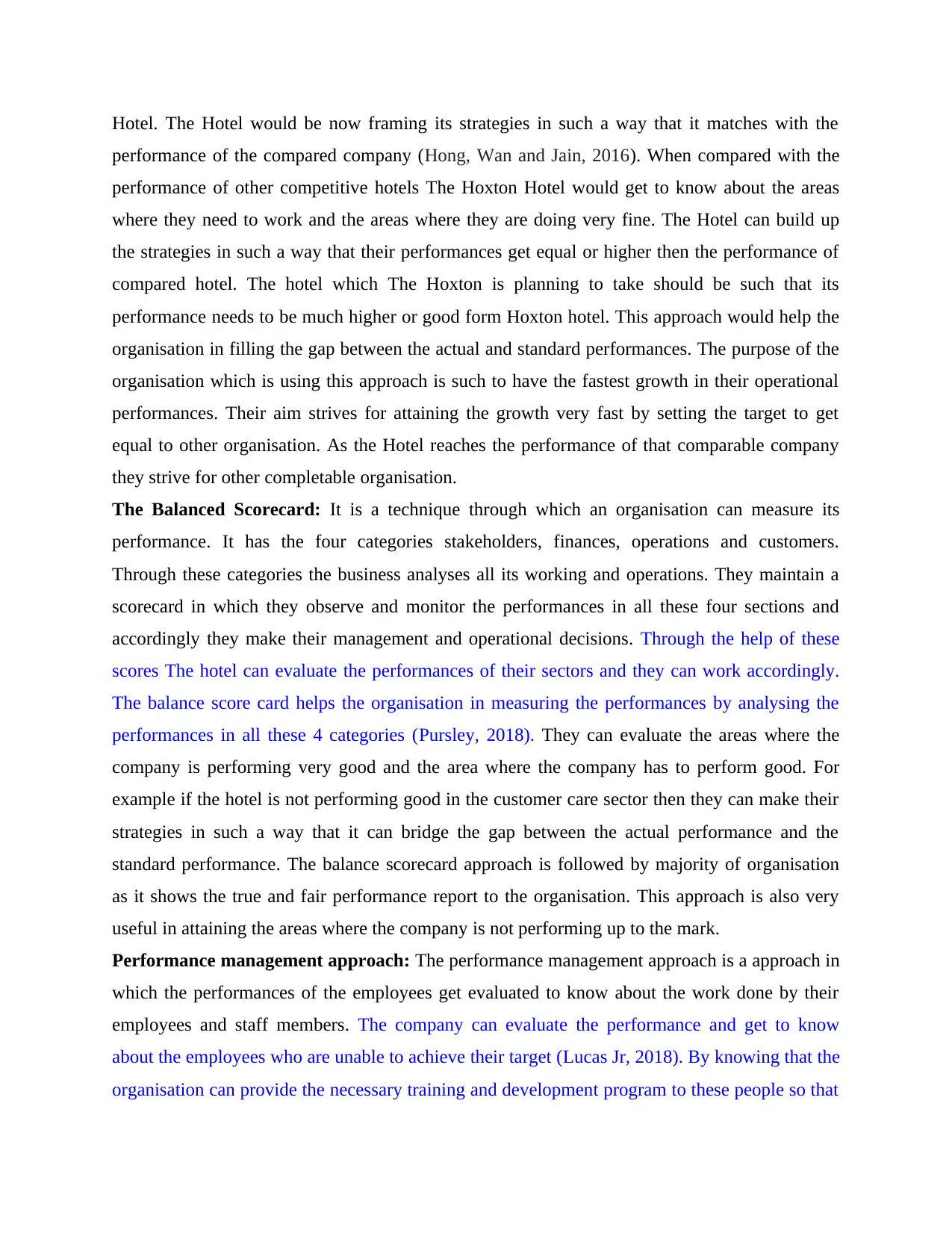
Hotel. The Hotel would be now framing its strategies in such a way that it matches with the
performance of the compared company (Hong, Wan and Jain, 2016). When compared with the
performance of other competitive hotels The Hoxton Hotel would get to know about the areas
where they need to work and the areas where they are doing very fine. The Hotel can build up
the strategies in such a way that their performances get equal or higher then the performance of
compared hotel. The hotel which The Hoxton is planning to take should be such that its
performance needs to be much higher or good form Hoxton hotel. This approach would help the
organisation in filling the gap between the actual and standard performances. The purpose of the
organisation which is using this approach is such to have the fastest growth in their operational
performances. Their aim strives for attaining the growth very fast by setting the target to get
equal to other organisation. As the Hotel reaches the performance of that comparable company
they strive for other completable organisation.
The Balanced Scorecard: It is a technique through which an organisation can measure its
performance. It has the four categories stakeholders, finances, operations and customers.
Through these categories the business analyses all its working and operations. They maintain a
scorecard in which they observe and monitor the performances in all these four sections and
accordingly they make their management and operational decisions. Through the help of these
scores The hotel can evaluate the performances of their sectors and they can work accordingly.
The balance score card helps the organisation in measuring the performances by analysing the
performances in all these 4 categories (Pursley, 2018). They can evaluate the areas where the
company is performing very good and the area where the company has to perform good. For
example if the hotel is not performing good in the customer care sector then they can make their
strategies in such a way that it can bridge the gap between the actual performance and the
standard performance. The balance scorecard approach is followed by majority of organisation
as it shows the true and fair performance report to the organisation. This approach is also very
useful in attaining the areas where the company is not performing up to the mark.
Performance management approach: The performance management approach is a approach in
which the performances of the employees get evaluated to know about the work done by their
employees and staff members. The company can evaluate the performance and get to know
about the employees who are unable to achieve their target (Lucas Jr, 2018). By knowing that the
organisation can provide the necessary training and development program to these people so that
performance of the compared company (Hong, Wan and Jain, 2016). When compared with the
performance of other competitive hotels The Hoxton Hotel would get to know about the areas
where they need to work and the areas where they are doing very fine. The Hotel can build up
the strategies in such a way that their performances get equal or higher then the performance of
compared hotel. The hotel which The Hoxton is planning to take should be such that its
performance needs to be much higher or good form Hoxton hotel. This approach would help the
organisation in filling the gap between the actual and standard performances. The purpose of the
organisation which is using this approach is such to have the fastest growth in their operational
performances. Their aim strives for attaining the growth very fast by setting the target to get
equal to other organisation. As the Hotel reaches the performance of that comparable company
they strive for other completable organisation.
The Balanced Scorecard: It is a technique through which an organisation can measure its
performance. It has the four categories stakeholders, finances, operations and customers.
Through these categories the business analyses all its working and operations. They maintain a
scorecard in which they observe and monitor the performances in all these four sections and
accordingly they make their management and operational decisions. Through the help of these
scores The hotel can evaluate the performances of their sectors and they can work accordingly.
The balance score card helps the organisation in measuring the performances by analysing the
performances in all these 4 categories (Pursley, 2018). They can evaluate the areas where the
company is performing very good and the area where the company has to perform good. For
example if the hotel is not performing good in the customer care sector then they can make their
strategies in such a way that it can bridge the gap between the actual performance and the
standard performance. The balance scorecard approach is followed by majority of organisation
as it shows the true and fair performance report to the organisation. This approach is also very
useful in attaining the areas where the company is not performing up to the mark.
Performance management approach: The performance management approach is a approach in
which the performances of the employees get evaluated to know about the work done by their
employees and staff members. The company can evaluate the performance and get to know
about the employees who are unable to achieve their target (Lucas Jr, 2018). By knowing that the
organisation can provide the necessary training and development program to these people so that
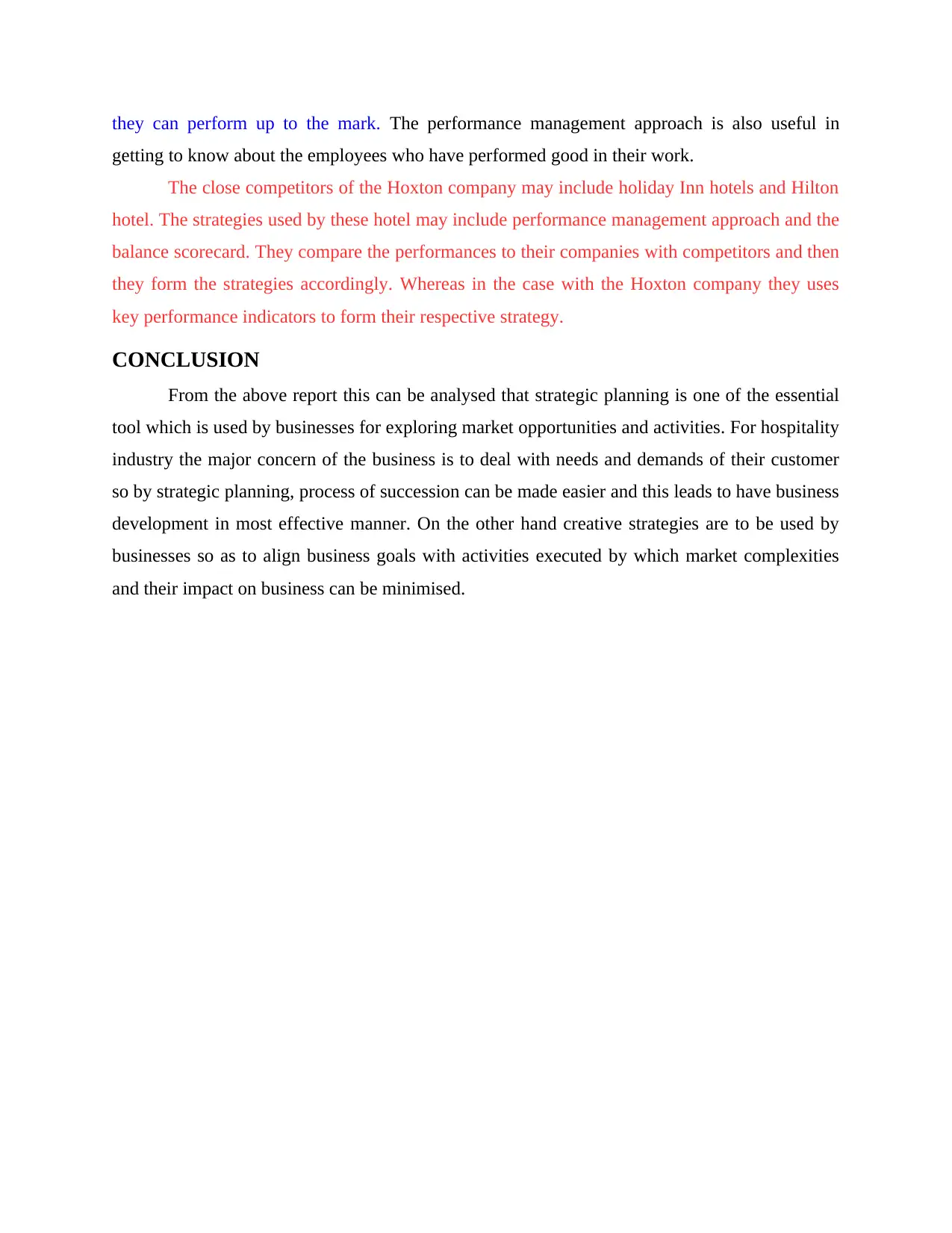
they can perform up to the mark. The performance management approach is also useful in
getting to know about the employees who have performed good in their work.
The close competitors of the Hoxton company may include holiday Inn hotels and Hilton
hotel. The strategies used by these hotel may include performance management approach and the
balance scorecard. They compare the performances to their companies with competitors and then
they form the strategies accordingly. Whereas in the case with the Hoxton company they uses
key performance indicators to form their respective strategy.
CONCLUSION
From the above report this can be analysed that strategic planning is one of the essential
tool which is used by businesses for exploring market opportunities and activities. For hospitality
industry the major concern of the business is to deal with needs and demands of their customer
so by strategic planning, process of succession can be made easier and this leads to have business
development in most effective manner. On the other hand creative strategies are to be used by
businesses so as to align business goals with activities executed by which market complexities
and their impact on business can be minimised.
getting to know about the employees who have performed good in their work.
The close competitors of the Hoxton company may include holiday Inn hotels and Hilton
hotel. The strategies used by these hotel may include performance management approach and the
balance scorecard. They compare the performances to their companies with competitors and then
they form the strategies accordingly. Whereas in the case with the Hoxton company they uses
key performance indicators to form their respective strategy.
CONCLUSION
From the above report this can be analysed that strategic planning is one of the essential
tool which is used by businesses for exploring market opportunities and activities. For hospitality
industry the major concern of the business is to deal with needs and demands of their customer
so by strategic planning, process of succession can be made easier and this leads to have business
development in most effective manner. On the other hand creative strategies are to be used by
businesses so as to align business goals with activities executed by which market complexities
and their impact on business can be minimised.
⊘ This is a preview!⊘
Do you want full access?
Subscribe today to unlock all pages.

Trusted by 1+ million students worldwide
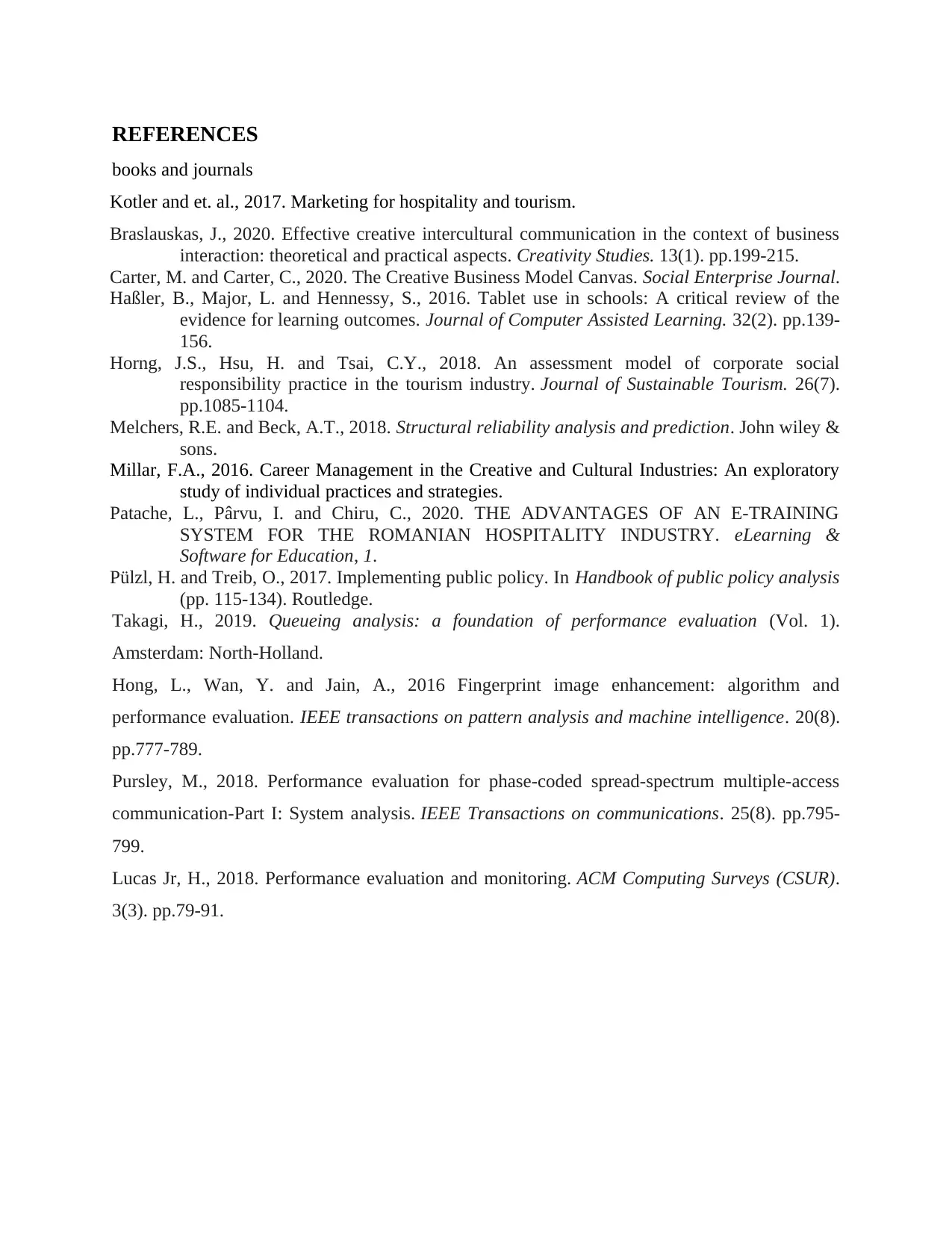
REFERENCES
books and journals
Kotler and et. al., 2017. Marketing for hospitality and tourism.
Braslauskas, J., 2020. Effective creative intercultural communication in the context of business
interaction: theoretical and practical aspects. Creativity Studies. 13(1). pp.199-215.
Carter, M. and Carter, C., 2020. The Creative Business Model Canvas. Social Enterprise Journal.
Haßler, B., Major, L. and Hennessy, S., 2016. Tablet use in schools: A critical review of the
evidence for learning outcomes. Journal of Computer Assisted Learning. 32(2). pp.139-
156.
Horng, J.S., Hsu, H. and Tsai, C.Y., 2018. An assessment model of corporate social
responsibility practice in the tourism industry. Journal of Sustainable Tourism. 26(7).
pp.1085-1104.
Melchers, R.E. and Beck, A.T., 2018. Structural reliability analysis and prediction. John wiley &
sons.
Millar, F.A., 2016. Career Management in the Creative and Cultural Industries: An exploratory
study of individual practices and strategies.
Patache, L., Pârvu, I. and Chiru, C., 2020. THE ADVANTAGES OF AN E-TRAINING
SYSTEM FOR THE ROMANIAN HOSPITALITY INDUSTRY. eLearning &
Software for Education, 1.
Pülzl, H. and Treib, O., 2017. Implementing public policy. In Handbook of public policy analysis
(pp. 115-134). Routledge.
Takagi, H., 2019. Queueing analysis: a foundation of performance evaluation (Vol. 1).
Amsterdam: North-Holland.
Hong, L., Wan, Y. and Jain, A., 2016 Fingerprint image enhancement: algorithm and
performance evaluation. IEEE transactions on pattern analysis and machine intelligence. 20(8).
pp.777-789.
Pursley, M., 2018. Performance evaluation for phase-coded spread-spectrum multiple-access
communication-Part I: System analysis. IEEE Transactions on communications. 25(8). pp.795-
799.
Lucas Jr, H., 2018. Performance evaluation and monitoring. ACM Computing Surveys (CSUR).
3(3). pp.79-91.
books and journals
Kotler and et. al., 2017. Marketing for hospitality and tourism.
Braslauskas, J., 2020. Effective creative intercultural communication in the context of business
interaction: theoretical and practical aspects. Creativity Studies. 13(1). pp.199-215.
Carter, M. and Carter, C., 2020. The Creative Business Model Canvas. Social Enterprise Journal.
Haßler, B., Major, L. and Hennessy, S., 2016. Tablet use in schools: A critical review of the
evidence for learning outcomes. Journal of Computer Assisted Learning. 32(2). pp.139-
156.
Horng, J.S., Hsu, H. and Tsai, C.Y., 2018. An assessment model of corporate social
responsibility practice in the tourism industry. Journal of Sustainable Tourism. 26(7).
pp.1085-1104.
Melchers, R.E. and Beck, A.T., 2018. Structural reliability analysis and prediction. John wiley &
sons.
Millar, F.A., 2016. Career Management in the Creative and Cultural Industries: An exploratory
study of individual practices and strategies.
Patache, L., Pârvu, I. and Chiru, C., 2020. THE ADVANTAGES OF AN E-TRAINING
SYSTEM FOR THE ROMANIAN HOSPITALITY INDUSTRY. eLearning &
Software for Education, 1.
Pülzl, H. and Treib, O., 2017. Implementing public policy. In Handbook of public policy analysis
(pp. 115-134). Routledge.
Takagi, H., 2019. Queueing analysis: a foundation of performance evaluation (Vol. 1).
Amsterdam: North-Holland.
Hong, L., Wan, Y. and Jain, A., 2016 Fingerprint image enhancement: algorithm and
performance evaluation. IEEE transactions on pattern analysis and machine intelligence. 20(8).
pp.777-789.
Pursley, M., 2018. Performance evaluation for phase-coded spread-spectrum multiple-access
communication-Part I: System analysis. IEEE Transactions on communications. 25(8). pp.795-
799.
Lucas Jr, H., 2018. Performance evaluation and monitoring. ACM Computing Surveys (CSUR).
3(3). pp.79-91.
1 out of 10
Related Documents
Your All-in-One AI-Powered Toolkit for Academic Success.
+13062052269
info@desklib.com
Available 24*7 on WhatsApp / Email
![[object Object]](/_next/static/media/star-bottom.7253800d.svg)
Unlock your academic potential
Copyright © 2020–2025 A2Z Services. All Rights Reserved. Developed and managed by ZUCOL.





